What Does Diamond Recycling Mean for Investors?
Recycling is a topic that doesn’t often come up in the diamond industry. After all, diamonds are supposed to be forever. However, it’s becoming increasingly crucial for those interested in the gems to be aware of how recycling affects supply and demand.
Recycling is a topic that doesn’t often come up in the diamond industry. After all, diamonds are supposed to be forever. However, it’s becoming increasingly crucial for those interested in the gems to be aware of how recycling affects supply and demand.
Diamond recycling is generally described as what happens when previously purchased gems re-enter the market, and it’s been happening more often lately. And while the 2008/2009 financial crisis is partially to blame, it seems that De Beers’ 1947 “a diamond is forever” slogan is the larger culprit.
As independent diamond industry analyst Paul Zimnisky explained to Diamond Investing News, the campaign was originally aimed at the baby boomer generation, and met with great success — that demographic “bought approximately 40 percent of the global diamond supply for over 20 years.” But with baby boomers are now aging, the diamonds they bought — which equate “to possibly half a billion carats” — are set to “end up in the hands of new owners in the coming years.”
How much of an impact?
According to Zimnisky, over the last 10 years, diamond recycling “has grown from less than 5 percent to closer to 10 percent of global supply.” That’s a small amount, especially when compared to the extent that other commodities are recycled — for instance, Zimnisky said that about 35 percent of gold comes from recycled sources.
That, of course, means that those interested in investing in diamond stocks probably don’t have much to worry about — it doesn’t look like recycled supply is likely to pose a major threat to mine supply any time soon. That said, it’s worth noting that industry heavyweights are beginning to take note of the increasing prevalence of diamond recycling.
For instance, Ezriel Rapaport, director of global trading for the Rapaport Group, said in a 2013 presentation, ”there’s more diamonds coming out of America today than South Africa,” adding, “it’s today’s reality. And we take this very seriously.” So seriously that his company — along with many others — is looking at sourcing diamonds from pawn shops and the like in the US, where they can be bought cheaply.
More recently, this past summer diamond giant De Beers announced the launch of a program aimed at “generat[ing] better insight on the scale of consumer re-selling activity and, more specifically, the consumer experience from those who look to re-sell their diamonds, and its impact on the lasting value benefit of diamond ownership.” It kicked off in September and is scheduled to run in the US until the start of 2015.
Based on that announcement, De Beers sounds more curious about diamond recycling than concerned about it. However, a recent BDlive article that quotes Des Kilalea, a diamond analyst with RBC Capital Markets in London, as saying, “De Beers is becoming a bit worried — I don’t think if the second-hand stones get decent prices, but the concern is if they are selling at more or less what the rough stones do.”
The ethical angle
As Rapaport noted, recycled diamonds are appealing in part due to their price. But that’s not the only thing that they have going for them — many diamond recyclers have pointed out that recycled gems are superior for ethical reasons.
For example, Hoover & Strong’s Harmony Metals and Gems division, through which customers can purchase recycled diamonds, states that by selling such gems it’s helping to “reduce the industry’s reliance on environmentally damaging mining practices.” Similarly, major diamond recycler White Pine Trading frames itself as cleaning up the industry’s waste, noting that much of its business is concerned with creating valuable matching parcels of small diamonds that individually have “little or no value.”
In today’s increasingly environmentally conscious world, such considerations might tempt buyers to seek out new recycled diamonds instead of heading to the store to buy a new one.
The upshot
All in all, the above information reveals that while recycled diamond supply is perhaps not much of an issue currently, in the coming years it could begin to play a bigger role in supply-demand dynamics. Investors would thus do well to keep an eye out for developments — De Beers’ upcoming report on the industry may be a good starting point.
Securities Disclosure: I, Charlotte McLeod, hold no direct investment interest in any company mentioned in this article.
